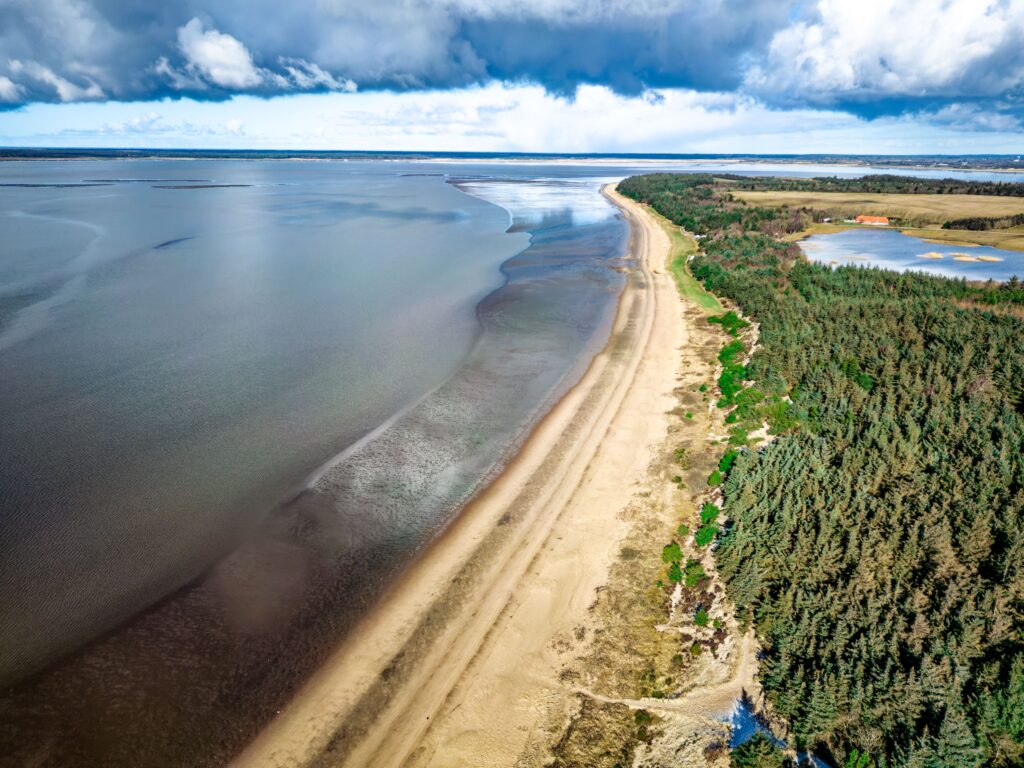Most observers think of heat pumps as small-scale heating systems for houses, businesses and apartment buildings. But XXL heat pumps are already in service and doing the same job for whole city districts. Their practice, if successful, will be an important asset in decarbonizing societies and economies. Paul Hockenos reports.

Credits: Frank Bach | Shutterstock, All rights reserved.
The city of Esbjerg, Denmark, is out in front – but not for long.
It boasts two industrial-size heat pumps that provide the city of 100,000 with heat from a vast resource right off its coast, namely the Wadden Sea. The goal: to replace Esbjerg’s coal-fired power plant, at least in part, and eventually in full.
The heat pumps extract heat from the seawater using CO2 as a natural refrigerant to transport the heat and bring it to a higher temperature level. The seawater heat pumps, manufactured by the German company MAN, have a combined heating capacity of 70 MW, and since 2025 operate in tandem with a 60-MW wood-chip boiler and a 40-MW electric boiler plant. The mixed technologies minimize investment and operational costs, and add to flexibility against fluctuating fuel and power market conditions.
They will supply domestic heating customers with approximately 280,000 MWh of carbon-free heat annually. No heat pump has ever generated so much heat, but the Esbjerg pumps won’t remain top of the pile for long. In Cologne, MAN has another under construction that will have twice the capacity.
There is a consensus in Europe that heat pumps are critical to decarbonizing heat generation. The system supplier GEA group concludes: ‘Electrically driven heat pumps are able to replace conventional heating systems based on fossil fuels. They use either available process waste heat or other heat sources from the environment and transfer the heat to a high temperature level. Even when using pure coal power, for example, a heat pump is much more sustainable than conventional boilers thanks to its outstanding efficiency, as it only requires around a third of the primary energy of a boiler to deliver the same output.’
The mega-scale systems are unique and innovative in more ways than one: they also serve as peak and backup load facilities. This capability to operate flexibly – it can ramp up from minimum load to maximum load, and from (hot) standby to full load, in less than 30 seconds – makes them multipurpose systems. They can readily balance the electrical grid by, for example, supporting the integration of weather-dependent power generation like solar and wind, according to MAN Energy Solutions.
The Danish pilot project ‘demonstrates that large-scale seawater heat pumps utilizing the non-toxic natural refrigerant CO2 are technically possible and economically feasible,’ according to the IEA Technology Collaboration Programme on Heat Pumping Technologies.
As Denmark has extensive district heating networks, it believes that it will generate half of its heat by way of electricity by 2035. District heating concepts are also seen as a key measure for decarbonizing Germany’s heating sector, which the previous government of Social Democrats, Greens and Liberals planned to facilitate by adding 100,000 households a year to district heat networks. The new government, led by the Christian Democrats, agrees that Germany should have more district heating but does not specific a per year figure.
More in Germany
Germany already has several large heat pumps, including one not far from my office in Berlin-Neukölln, though they are not nearly the size of Esbjerg’s. In Neukölln, one of the 8.5-ton units is connected to several large-scale boilers and seven combined heat and power (CHP) units are situated at the heating plant site. The fuels used include fossil gas, wood pellets, hard coal, biomethane and heating oil. Alongside a planned CHP-powered air-cooling system, further potential heat sources (river water heat and geothermal energy) will become available. The new technology gives waste heat a use and increases the energy efficiency of cold generation, as well as providing green heat from renewable electricity.
The heat from the pumps in Berlin-Neukölln and adjacent Berlin-Kreuzberg reaches around 55,000 connected households in the form of hot water. The water releases its heat and flows back to the Neukölln plant through a circulation system. With approximately two to four kilometres of pipe being laid every year, this district heating network now extends across a significant portion of the Neukölln and Kreuzberg neighbourhoods.
The German think tank Agora Energiewende argues that the entire heat demand in Germany up to 200 degrees can technically be covered by heat pumps. ‘As part of this, large-scale heat pumps can exploit considerable potentials offered by geothermal energy, water bodies and waste heat,’ it argues in a report. ‘By 2045, large-scale heat pumps could provide 70 percent of the district heating supply and thus replace a very large proportion of the fossil gas used.’
Stuttgart and Mannheim
The largest German heat pump will soon be in Stuttgart, constructed by EnBW, where waste heat from the cooling water drained from a CHP site will generate up to 24 MW for district heating.
In Germany, in addition to Stuttgart, there are plans to install large heat pumps in Berlin-Neukölln, Mannheim and Rosenheim, which will be operative by spring 2026 – all supported by the Federal Ministry for Economic Affairs and Energy. Getting in on the superlatives, Mannheim will boast the largest river-based heat pump in the country, using water from the Rhine River to heat 3,500 households.
Agora Energiewende underscores that the roll-out of large-scale heat pumps needs state assistance. The larger project of decarbonizing Germany’s heating ‘requires a triad consisting of strategic goals and incentives from the public authorities, technological innovation on the part of manufacturers, and accelerated implementation by district heating providers and industry.’
A climate-neutral heat supply is crucial for Germany to hit its climate targets. With giant heat pumps at the ready, it would seem that nothing on Agora Energiewende’s to-do list is beyond Germany or the EU.
The views and opinions in this article do not necessarily reflect those of the Heinrich-Böll-Stiftung European Union.
